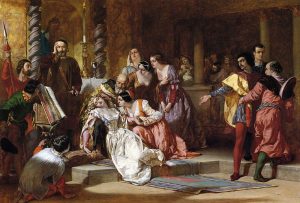
Okay, so this wasn’t quite the type of camp we had.
In last week’s posts (here and on CatherineJaime.com) I mentioned two of the many ways we experienced Shakespeare at the No Kidding Shakespeare camp I recently attended. A camp for adults, who knew?
My Methods for Sharing
Today I will share several others. But first, I want to reiterate a couple of things from my first post on Sharing Shakespeare: in the twenty years that I’ve taught Shakespeare I’ve settled into a fairly simple way of sharing Shakespeare with my students – passing out characters in order to read the plays aloud together, and watching the plays (live and on video). There are distinct advantages to both the reading and the watching, and over the years I’ve done both, sometimes starting with one and sometimes starting with the other. (Though last year I had an unusual group of students – they didn’t want to spend any of our class time watching plays – they were enjoying the reading too much! Since this group included a couple of young men with no prior experience reading Shakespeare, I was not going to argue!)
To Read Them All or Not To Read Them All

Enough Comedies, Tragedies, and Histories to last a LONG time!
Overall, I have found that method to be very successful – I have introduced countless students to the wonderful words of the Bard that way. And I certainly won’t be making any major changes this year. (The one year I tried a major shift got off to a really bad start, until I went back to the tried and true.) But what I do plan to do is work in a few of the activities we did at camp around our reading – starting or ending several class periods with an activity that relates to that week’s class. That will mean spending more time on one play, but I have no problem with that. Years ago we had a three and a half year push to read every one of Shakespeare’s plays aloud in class, but since then we’ve settled for making our way slowly through some of the best. (Reading each play was a great accomplishment, but it is certainly not for the faint of heart!)
Dramatic Activities with Shakespeare
But, with no further ado, here are some of the other neat activities we did at camp that I’m hoping to incorporate this fall:
Speaking Sculptures
For this activity we each received a line from a play and then had to walk around the stage reciting the line as we followed different instructions we were being given – walk faster, walk slower, speak the line faster, speak louder, those types of things. I think the idea there was for us to become comfortable with our line, and to experience it in different ways.

A scene from Much Ado
Then we paired off with the person closest to us. We were to instruct our partner to stand in a pose that somehow went with our line. The challenge was that we were not supposed to talk to our partners, nor touch them – we were supposed to get them into position with merely the suggestion of our hands. And I’m sure my students will give me the same blank looks that you’re trying to give me right about now. (It’s definitely something that’s easier to explain through showing than through words, so you’ll just have to take my word for this portion.) Once each partner was in position they were given the other’s line to speak. As half of the group stood as” speaking sculptures,” the other half wandered around and looked and listened. Then we swapped places and repeated the process.
“Forming” the sculpture was indeed a challenge. But it was interesting to wander around and listen to the different lines. I hadn’t recognized my own line or my partner’s line, but as I moved from sculpture to sculpture I did recognize some of the others as being from Much Ado About Nothing. It turned out all of them were from Much Ado.
Introducing a Play?

A rendition of Taming of the Shrew
I’m thinking that might be a fun way to introduce whatever play we’re starting with this fall. (Sadly, I’m still deciding which one we’re going to do first – so many good ones to choose from – so I can’t start getting lines prepared for this quite yet.) One of the plays the American Shakespeare Center folks will be bringing to Huntsville in February is Taming of the Shrew, so it’s at least in the running for our first play of the semester, depending on how long ago we last read it.
Once I have our first play chosen, I can pick lines for the students to practice speaking and sculpting. I wonder if they’ll be able to figure out which play it is any faster than I did. Time will tell!
Snapshots of a Scene
 For another one of our activities we were broken into small groups, each with a portion of a different scene. Each group had the same number of people as their scene had characters. As a group we had to choose five places from our scene that we could take “snapshots” of – where we could quickly “act” them out (more of a posed three-dimensional picture for each place.) The idea was to visually represent the highlights of our little scene.
For another one of our activities we were broken into small groups, each with a portion of a different scene. Each group had the same number of people as their scene had characters. As a group we had to choose five places from our scene that we could take “snapshots” of – where we could quickly “act” them out (more of a posed three-dimensional picture for each place.) The idea was to visually represent the highlights of our little scene.
I’ve never considered myself much of a drama person (I know, I know, I teach Shakespeare, but that’s different!). But I really enjoyed the various activities we did like this one.
Varying the Tempo
Another time we were in similar small groups with a different short passage. We were instructed to start by reading aloud our passage (adding limited movements if we wanted). Then we had to read it again several times, varying the tempo and emphasis of individual portions as we read. We could see (or actually, hear) what the small changes we made to our reading did for the overall feeling of our section.
Using These in Class
 I don’t want to turn my Shakespeare classes into acting classes – plenty of others already offer those. I want to keep my emphasis on reading and enjoying Shakespeare. But I can see how these types of activities, sprinkled sporadically amongst our readings could add a new dimension to our Shakespeare understanding and enjoyment.
I don’t want to turn my Shakespeare classes into acting classes – plenty of others already offer those. I want to keep my emphasis on reading and enjoying Shakespeare. But I can see how these types of activities, sprinkled sporadically amongst our readings could add a new dimension to our Shakespeare understanding and enjoyment.
More to Come
I’m not sure if I’ve shared about all of the great activities we did at camp yet. (I still haven’t gotten home, unpacked from that trip, and relocated my notes!) But either way I should have more to share within a week or two. I’m planning to go back to Staunton to attend their Teacher Seminar. in early August. Hey, we’re on a roll here! Maybe by then I can nail down which play(s) we’ll be tackling this fall and start figuring out where to work in these various, fun activities.

Actors before Hamlet
In the meantime, if you are already planning to share Shakespeare with your (older) students next year, I hope these different ideas are helpful. And if you’re aren’t, maybe you could reconsider. Overall, I’m a big fan of middle school and high school students spending lots of time with Shakespeare, but not so keen on younger students being exposed to his work. Adult themes permeate these plays, and I don’t see the benefit of sharing those with our youngsters quite yet, but maybe that’s just me. Some of my students have enjoyed Shakespeare with me for as many as four or five years. (What can I say, I don’t think they can get too much Shakespeare!)
Remember, as Hamlet said so many years ago, “The play’s the thing.”
Happy reading!
Cathy


Leave a Reply